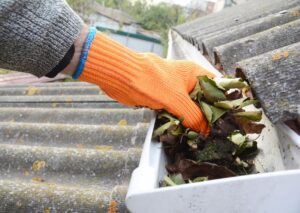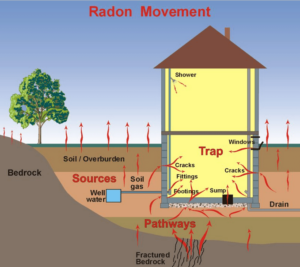Gutter cleaning is an important home maintenance task that helps ward off foundation damage, roof leaks, and other issues. However, the chore is risky because it requires working on a ladder.
Gutter inspections help homeowners avoid costly gutter-cleaning mistakes. To make the process safer, consider these tips: Use thick, sturdy gloves and wear protective eyewear. For more information, you can visit Roof Cleaning MT Pleasant to proceed.

Gutters play a vital role in your home’s structure, as they are designed to channel rainwater off your roof and away from the foundation of your house. When gutters are clogged, this can cause water to pool around your foundation, leading to damage. This damage may lead to cracks in the foundation of your home, and it can also cause many problems with the walls of your home, including staining and mold. Calling your insurance agent as soon as possible is important if this happens. The damage caused by clogged gutters will most likely not be covered under your homeowner’s insurance.
Water from a clogged gutter will flow over the sides of your house and seep into any opening it can find, including the basement. This can damage your drywall, causing mold or mildew and rotting wood. It can also damage your carpet and other flooring materials. In addition, a wet basement can ruin furniture and other expensive items stored in the area. Regular gutter cleaning can help prevent this problem.
A clogged gutter can also cause water to pool on your roof, damaging the shingles and tiles. Over time, this can lead to a leaky roof that must be repaired or replaced.
When you clean your gutters regularly, they can last longer and stay in good condition. However, they can become clogged with leaves, sticks, dirt, and other debris if you don’t clean them. In this case, the downspout may also get blocked and stop functioning properly.
Unmaintained gutters can also become breeding grounds for mosquitoes and other insects. The stagnant water provides a perfect environment for them to reproduce, and the organic material in the gutters can provide food for them as they breed. In addition, the pests can then move into your home, creating a new problem you’ll need to deal with. Regular gutter cleaning can prevent this problem and keep your home free of bugs and other unwanted pests.
Gutter systems are designed to funnel rainwater off your roof and away from your home’s foundation. If they become clogged, the water that normally would drain out of the downspouts will instead begin to pool around your house. Eventually, this can cause damage to your walls, flooring, furniture, and other items stored in your basement.
Water that pools in the gutter can also erode the soil underneath your foundation. This is especially dangerous for older homes with a concrete or mortar foundation. The foundation can crack or even collapse if the deterioration is severe enough.
If you notice that your basement floods every time it rains, this is usually a sign that your gutters are clogged. In addition, the flooding will create a breeding ground for mold and mildew. These spores can spread throughout your home, causing respiratory problems and other health issues.
Regularly cleaned gutters can prevent this type of damage to your home. By having your gutters cleaned before a storm or when you see signs of a clog, you can avoid the expensive repair costs associated with basement flooding.
Your gutters are a vital part of your home. They are designed to keep rainwater and other debris from damaging your house, but if they become clogged, this can cause major damage to your property. Gutter cleaning is one of the most important things you can do to protect your home from costly repairs and ensure that your gutter system is working properly.
All of the water that lands on your roof is drained down and into the gutters, which then drains out the downspouts. However, if your gutters are clogged, the water cannot pass through them. Over time, the clog will only get worse as more and more debris becomes lodged inside the downspout. If left unchecked, the downspout will eventually become completely clogged so that no water can pass through, and your home will begin to leak from the downspouts. This is another reason why it is important to clean your gutters at least once a year.
All rain and snow that lands on your roof must travel through your gutters to get away from the house. When your gutters are clogged, excess water has nowhere to go and will start seeping into the joints between your roof and walls and into the ceilings of your home. This can lead to wood rot, mold growth, and mildew, requiring expensive repair.
Another important function of your gutters is to channel rainwater and snow away from your home’s foundation. When your gutters are clogged, the water will pool around the foundation and may seep into the basement. This can result in mold and mildew, which is unsightly and could create a health hazard for you and your family.
Gutters live at the top of your home, below your roof, and above the walls, nailed to the fascia board. When the channels are clogged, pooled water can overflow onto these exposed wooden areas, causing damage to your siding, roof, and fascia board. This damage can lead to mold, mildew, rot, and insect infestation if left untreated.
If you notice stains on your walls or attic ceiling, this is a sign that your gutters are clogged and overflowing. Inspecting your gutters and downspouts after heavy rainfall and before a severe storm would be best to ensure they are debris-free.
The best way to ensure your gutters are not clogged is to keep up with regular cleaning. A good rule of thumb is to clean your gutters twice a year, but more frequent cleanings are recommended if you have large trees that overhang the house or if your gutters have a lot of twigs and leaves in them. Another way to prevent clogs is to trim overhanging branches too close to the house and install downspout screens to catch smaller debris. Another important thing to remember when cleaning your gutters is to work from a ladder that’s stable and safe enough for you to use. Avoid overreaching, which can cause you to fall off the ladder and hurt yourself.
Gutters funnel water off your roof through downspouts, away from your home’s foundation. When clogged, they can no longer do their job, and rainwater pools around the base of your house pour down walls, and floods your basement. This can also cause rot and mold on the exterior of your house, damage landscaping, and ruin the look of your home’s façade.
Leaves, twigs, and other debris collected in clogged gutters serve as nesting sites for rodents, birds, mosquitoes, and other pests. These pests spread diseases such as West Nile Virus and Zika. Additionally, stagnant water and decomposing organic material in clogged gutters can provide the ideal environment for grass seeds to sprout and fungi to grow.
When you don’t clean your gutters, water that pools in the clogged area can wreak havoc on your roof and damage your home’s fascia boards, trim, and shingle sheets. This can result in leaks and even a collapsed roof. When you schedule preventative gutter cleaning services, you can avoid this damage and save on costly repair costs.
Gutter guards can help prevent clogging, but they don’t replace the need to clean your gutters regularly. If you are looking for a safe and effective way to clean your gutters, try a gutter vacuum system that allows you to stay on the ground instead of climbing a ladder.
If you climb a ladder to check and clean your gutters, always use caution. Make sure you have the right safety gear to ensure your safety, such as a sturdy ladder, gloves, and a bucket for the debris you collect. Also, never attempt to reach a high spot on your gutter or roof, as you can fall and injure yourself. Having a friend or family member hold the ladder while you work or hire a professional gutter cleaner is best.
